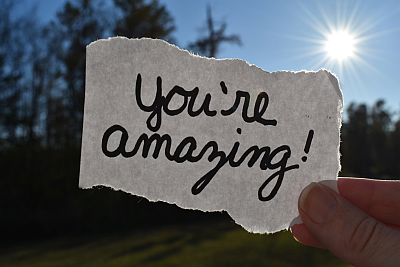Have you tried meditating?
Chances are that your answer may be an emphatic “yes” or an equally emphatic “no.” Meditation can be polarizing. People are either really into it—or really not. Meditation skeptics may think that it’s only for people who are into extreme wellness or dedicated health gurus.
But that kind of black-and-white thinking might keep you from reaping meditation’s significant health benefits.
Meditation can be especially helpful when we’re stressed, which could explain why the practice is growing in the United States. According to an annual survey by the Centers for Disease Control and Prevention (CDC), the percentage of adults who meditated has more than doubled in the last 20 years, from 7.5 to 17.3 percent.
If you’re thinking of giving meditation a try, here’s a primer on the science behind meditation, along with tips for getting started as a beginner (even a skeptical one!)
What Is Meditation?

Meditation is an ancient practice that uses mental and/or physical techniques to help you enter a relaxed state to relieve stress, calm your mind, and gain clarity.
Meditation can take many shapes and is unique to everyone who practices it.
In general, it’s a way to train your attention inward—quite the feat in today’s busy, distracted world. Meditation usually involves getting into a comfortable position and focusing your mind on certain thoughts, images, or sounds.
For many people, meditation is part of their personal and spiritual growth, as well.
Making the Case for Meditation
 If we know one thing, it’s that chronic stress is harmful to your overall health. It can leave you feeling overwhelmed, exhausted, and short-tempered. Prolonged stress can lead to mental health issues that need professional treatment, including depression and anxiety.
If we know one thing, it’s that chronic stress is harmful to your overall health. It can leave you feeling overwhelmed, exhausted, and short-tempered. Prolonged stress can lead to mental health issues that need professional treatment, including depression and anxiety.
Stress takes a physical toll, too. It can show up as aches and pains, high blood pressure, teeth grinding, sleeplessness, and a variety of other issues.
But stress is also a fact of modern life with school, work, and relationships—not to mention the news cycle taking over our feeds. You can’t always control the sources of stress in your life, but you can control how you cope with it. Meditation can be an important tool in your wellbeing toolbox.
Research on the potential benefits of meditation is relatively new and still evolving. Based on what we know so far, experts like those at the National Institutes of Health (NIH) say meditation could help you:
- Manage stress, anger, or grief;
- Improve your mood;
- Stay in the present (also known as mindfulness);
- Boost creativity, concentration, and problem-solving;
- Lower resting heart rate and blood pressure;
- Fall asleep faster and sleep better;
- Succeed at quitting tobacco/nicotine and other substances; and
- Manage or reduce symptoms associated with a variety of health conditions—both mental and physical.
The effects of meditation will vary based on your situation, how much you practice, and other factors. Also important to know: The Mayo Clinic notes meditation should complement other health treatments, not replace them.
Making Meditation Work for You
Meditation-curious? There are many reasons to meditate. There are also many reasons not to. After all, you’re already juggling daily life with other healthy habits like eating well, staying active, and getting enough sleep. Meditation also can be intimidating if you’ve never done it before.
Here are some tips for overcoming common barriers and trying meditation on your own terms.
If you don’t have time to meditate, sneak it in during your day.
You can meditate anytime, anywhere. And it’s free—no special equipment or fancy membership required!
Try meditating during downtime you might otherwise spend on your phone or another device. It could be when you’re waiting at the doctor’s office, riding the bus or train, or standing in line at the store.
Walking while meditating is also an option, says Harvard Health—for double the benefits!
If you think meditation is too “new age” for you, make it your own.
Know that saying, “Don’t knock it until you try it?” Meditation is meant to be a judgment-free zone, so keep an open mind. Bring up meditation with your family and friends and you may be surprised at who else is meditating, which could dispel some stereotypes.
Afraid of looking silly? You don’t need to lie down or even sit to meditate. Eyes opened or closed? It’s up to you. Just get comfortable!
If you’re not sure where to start, try guided meditation.

A little guidance can go a long way. One New York Times article explored a few popular meditation apps including Headspace, Calm, Simple Habit, and Insight Timer.
You can also try a meditation podcast or video, such as these free recordings from UCLA Health.
Or, if group experiences are more your thing, look for a meditation class with a live instructor.
These resources are all designed to lead you on a sensory journey by conjuring ideas, things, and places known to help people relax.
Gratitude is another framework for meditation. If you already keep a gratitude journal, spend a few moments contemplating what and who you’re thankful for before you pick up your pen. That’s meditation!
If you tend to get bored or restless, try meditation with movement.
Some types of exercise combine meditation with physical activity. Think yoga or tai chi, a gentle form of martial arts.
If you’re a nature lover, you can meditate on your next hike with the beautiful outdoors to inspire you.
If you have a hard time quieting your mind, focus on a single thing.
 Got “busy brain?” You’re far from alone. To overcome this, first choose a quiet space that’s free of distractions (your home office may not be the best setting).
Got “busy brain?” You’re far from alone. To overcome this, first choose a quiet space that’s free of distractions (your home office may not be the best setting).
Repeat a calming word or phrase to replace other thoughts. This is called a mantra. You can repeat your mantra aloud or in your head.
Another strategy is to concentrate on your breathing and imagine you’re letting out negative thoughts—and letting in positive, calming ones.
Still another meditation technique is the body scan, where you note and relax every part of your body from head to toe.
Mind still wandering? That’s normal. Gently bring it back to the center.
If you have trouble remembering, tie meditation to another daily habit.
 Know how breakfast triggers you to get started with your daily routine? Or how you automatically refill your water bottle every time it reaches a certain level?
Know how breakfast triggers you to get started with your daily routine? Or how you automatically refill your water bottle every time it reaches a certain level?
You can connect meditation to another part of your day, such as your daily walk or even the act of waking up.
Many people choose to meditate in the morning because it sets a nice tone for the rest of their day.
That said, choose the time that works best for you.
If you don’t think you can commit to meditating long-term, start small and keep it simple.
Meditation isn’t meant to be a burden. Commit to just five minutes a day.
Anyone can find five minutes!
Whether you stick with or increase that length, the health benefits will last well beyond each session. The more you practice meditation, the greater the benefits.
Peace of Mind
There’s no right or wrong way to meditate, which means anyone can give it a try. As with any healthy habit, remember it takes practice and that something is better than nothing. Aim for progress, not perfection. Be kind to yourself as you get the hang of it.
Who knows? Maybe meditation will fit into your healthy lifestyle better than you expected! And then you’ll have a powerful new tool for coping with life’s (inevitable) stressful situations.
Note: Since everyone’s health history and nutritional needs are so different, please make sure that you talk with your doctor and a registered dietitian to get advice about the diet and exercise plan that‘s right for you.

